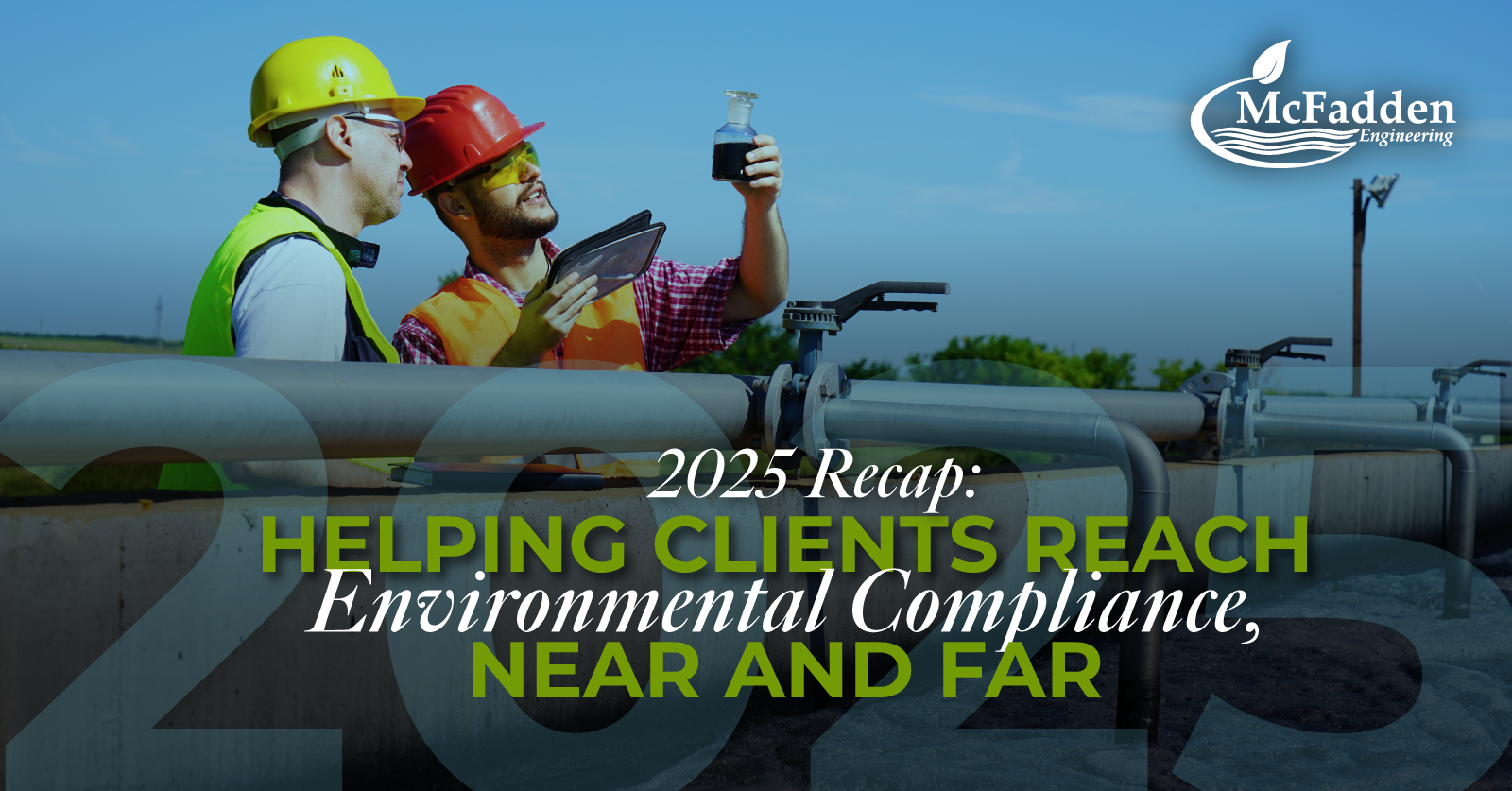2025 Recap: Helping Clients Reach Environmental Compliance, Near and Far
December 15, 2025
As 2025 comes to a close, our team is proud to reflect on our various projects and accomplishments. McFadden Engineering experienced a year of growth, expansion and continued commitment to sustainable environmental engineering solutions to even the most challenging water and wastewater problems.
Compliance Work with ArcelorMittal Calvert
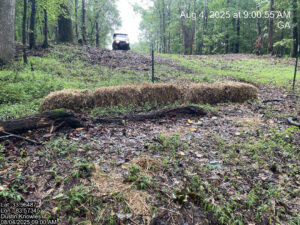
What began as a short-term compliance support project with AM Calvert, an industry-leading steel fabricator near Mobile, Ala., has evolved into ongoing work on a variety of engineering needs. McFadden supports AM Calvert through compliance monitoring, storm water monitoring, spill plan inspection services and implementation of best management practices (BMP).
In addition to compliance-related work, the McFadden team also upgraded AM Calvert’s sample collection systems by assisting the environmental team with designs to integrate auto-sampling equipment at numerous locations within the facility. McFadden has previously worked with AM Calvert on compliance for its steel mill, so the team welcomed the opportunity for an ongoing partnership.
Georgia Natural Gas Pipeline Project
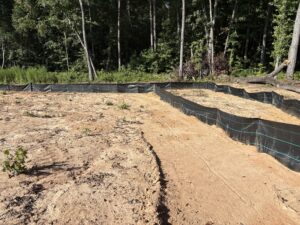 The installation and expansion of natural gas pipelines are a growing need across the country, including the Southeast. These projects are subject to strict environmental regulations, which made McFadden Engineering a perfect fit for ongoing environmental work for a large natural gas pipeline project in Northwest Georgia.
The installation and expansion of natural gas pipelines are a growing need across the country, including the Southeast. These projects are subject to strict environmental regulations, which made McFadden Engineering a perfect fit for ongoing environmental work for a large natural gas pipeline project in Northwest Georgia.
McFadden’s team of engineers worked on a 16-inch transmission pipeline construction project where they completed the environmental permitting and assisted with BMPs during Phase 1 of the construction. As Phases 2 and 3 prepare to begin, McFadden will continue its compliance work on the project.
Pipeline Hazardous Material (PHMSA) Department of Transportation Grants
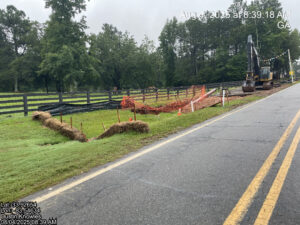
McFadden had additional opportunities to work in the natural gas sector this year thanks to Pipeline Hazardous Material (PHMSA) grants issued through the Department of Transportation (DOT). The grants support natural gas line upgrades for communities across the country, and the McFadden team spent time on the road to assist with the environmental work associated with the projects.
This year, the team has completed environmental work for associated projects in North Carolina, Ohio and Kansas. The work included evaluation of pipeline routes for environmental considerations such potential impacts on water bodies and wetlands, as well as the identification of environmentally sensitive areas within the project footprint.
Expanding Our Footprint
These projects and many others have culminated in a broader reach and an expanded footprint for McFadden Engineering during the past year. Our team continues to gain more work locally while also supporting projects across the country, from the Midwest to the East Coast and back down South.
We appreciate our clients near and far and look forward to continued growth in the coming year. If you need environmental compliance support in the new year, our team is here to help—browse our services and contact us today.
America Recycles Day: How Water Recycling Makes an Impact
November 10, 2025
Blue bins, the triangular logo, instructions listed on product packaging – recycling has become familiar and even mainstream in the United States in recent years. According to the Environmental Protection Agency (EPA), 32 percent of households recycle, but a recent report from The Recycling Partnership (TRP) indicates only 21 percent of residential recyclable items are being recycled. As the country recognizes America Recycles Day in November, it’s a great time to identify opportunities for recycling both at home and within industrial settings.
America Recycles Day
America Recycles Day is a day of recycling education and action sponsored by the EPA, with a goal of increasing the U.S. recycling rate both in homes and businesses.
Recycling reduces the amount of waste sent to landfills and incinerators, conserves natural resources, prevents pollution, creates jobs and saves energy, among other positive impacts on our communities and the environment. America Recycles Day emphasizes the need to not only recycle more, but to also “recycle right” to make the most impact.
In addition to recycling eligible materials like cardboard, plastic and glass, opting for reusable items plays a significant role in recycling efforts, too. Reusable tablecloths, dishes, cutlery, lunchboxes, water bottles, coffee mugs and other daily-use items are better for the environment than their single-use counterparts. Additionally, shopping for second-hand items instead of always buying new, and focusing on purchasing higher-quality items that have an extended life span, are easy ways to focus on reuse and recycling.

Recycling in Industry
Industrial waste recycling becomes necessary when businesses produce hard-to-recycle or hazardous materials. Businesses often produce common recyclable materials similar to household waste, including cardboard, paper, metal and plastic containers.
Various companies offer industrial recycling services, which can help keep industrial byproducts out of landfills. Organizations can also consider using already-recycled materials as substitutes for raw materials.
Water Recycling and Reclamation
While recycling solids is one avenue for environmentally friendly policy, water recycling and/or water reclamation can also have a major impact on industrial organizations and their communities.
Water recycling involves the treating and repurposing of wastewater for alternative uses. According to the EPA, recycled water is a reliable water source and can be used to protect against droughts, support industrial processes, protect rivers and streams and enhance groundwater supplies.
Sources of recycled water can include stormwater, municipal wastewater, bathroom and laundry water and industrial wastewater. To reuse water, it first must be treated to remove contaminants and chemicals and is then treated, per location-specific regulations and permit requirements as needed prior to distribution.
The Safe Drinking Water Act and Clean Water Act guide the EPA, state and local government programs to protect drinking water sources and other bodies of water.
McFadden Engineering Supports Water Recycling Efforts
 In addition to helping clients assess and remediate environmental engineering issues that relate to industrial recycling and regulatory compliance, the McFadden Engineering team developed OxyShark®, a multi-celled, fixed-film bioreactor capable of handling hundreds of thousands of gallons of wastewater per day.
In addition to helping clients assess and remediate environmental engineering issues that relate to industrial recycling and regulatory compliance, the McFadden Engineering team developed OxyShark®, a multi-celled, fixed-film bioreactor capable of handling hundreds of thousands of gallons of wastewater per day.
OxyShark® treats wastewater for discharge, reuse (e.g., washdown, cooling, landscaping), or regulatory compliance without hazardous chemicals, relying solely on beneficial bacteria and oxygen. This approach minimizes environmental risk and eliminates the cost of chemical treatments.
Water recycling can make a substantial impact on overall recycling efforts in industrial and municipal spaces, leading to improved efficiency, less risk of regulation violations and cleaner communities.
McFadden Engineering’s team of water and wastewater experts specializes in providing environmentally sound solutions to solve unique civil and environmental engineering needs. Visit the OxyShark® website for more information or contact our team today to inquire about how our team can support your industrial and water recycling needs.
Managing the Treatment and Disposal of Hazardous Waste
October 13, 2025
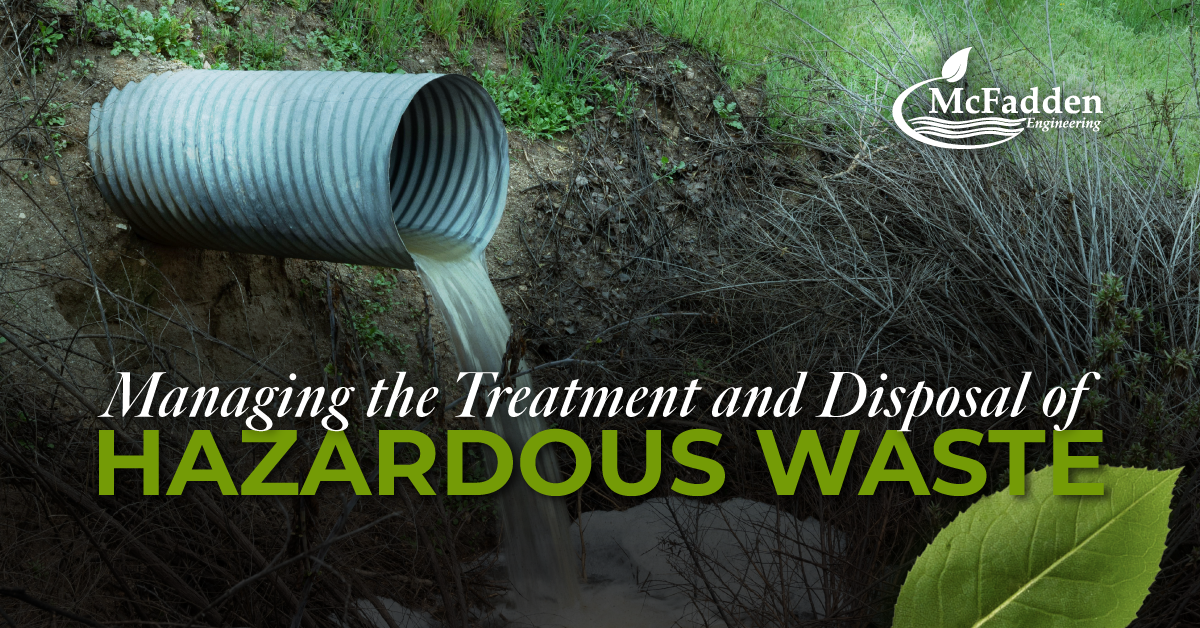
The City of Mobile recently hosted a free household hazardous waste collection event for its residents. Household hazardous waste includes items that are not routinely picked up by bulk trash and garbage collection services, as they can be harmful to the environment and to humans if not disposed of properly. Both personal households and businesses have a responsibility to their communities to minimize the impact their waste, particularly hazardous waste, has on the environment.
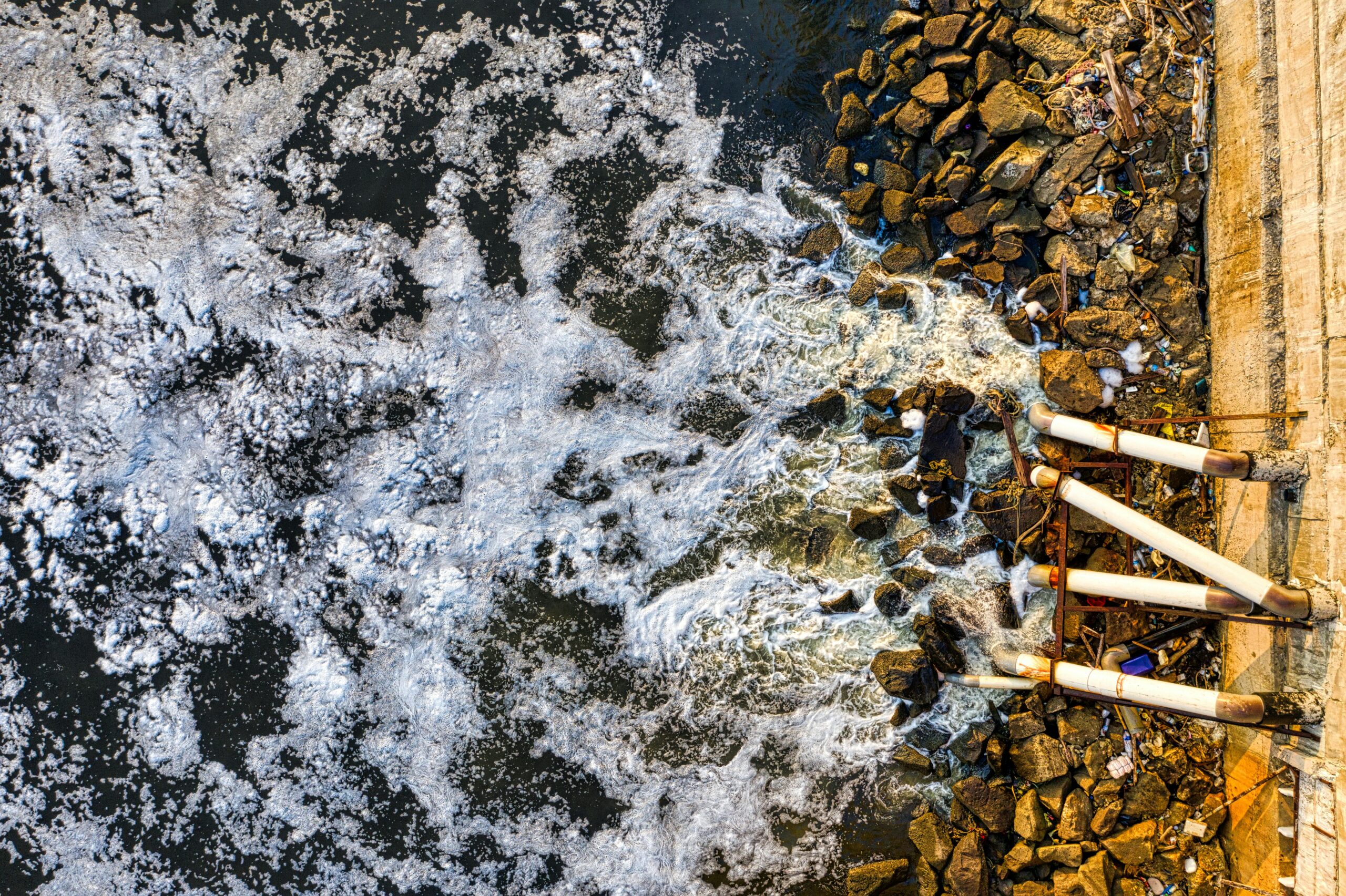
What is Hazardous Waste?
While common household items like paint, batteries, cleaners, fertilizers and medications often come to mind when discussing hazardous waste, industry is also a major contributor to hazardous waste issues. Many industrial manufacturing processes can produce hazardous waste in a variety of forms, including liquids, solids, gases and sludges. The Environmental Protection Agency (EPA) developed a regulatory definition and process that identifies hazardous substances and how they should be managed.
Industries that are prone to hazardous waste production include:
- Construction
- Dry Cleaning
- Educational and Vocational Shops (Automobile repair, Woodworking, Metalworking)
- Equipment Repair
- Furniture Manufacturing and Refinishing
- Laboratories
- Textile Manufacturing
- Transportation (Freight and Railroad)
- Pesticide Application and Cleanup
- Printing and Photo Processing
- Vehicle Maintenance
Companies in these industries must determine if they produce hazardous waste and, if so, must oversee waste processing, treatment and recycling or disposal. Examples of industrial hazardous waste include solvents, paints, pesticides, heavy metals and more.
Disposal and Recycling of Hazardous Waste
Regulations at both the federal and state levels are in place to help businesses recycle or dispose of hazardous waste properly. At the federal level, the EPA manages various standards, exclusions and exemptions for categories of hazardous waste – it is up to the business to understand the waste it produces and the regulations that apply in their industry and geographic location.
Proper disposal of hazardous industrial waste is critical to preserving the environment – especially drinking water – and protecting people from various toxins that can cause severe illness. Air, soil, water and wildlife are affected when hazardous waste disposal goes awry. Businesses can avoid costly fines and tarnished reputations by having a disposal plan in place.
Hazardous waste recycling is managed by its own set of regulations at the federal and state levels. When a material is reused, reclaimed or used in a way that constitutes disposal and burned for energy recovery, it is recycled. These approaches can reduce environmental hazards and protect natural resources.
At home, take-back programs like the one offered by the City of Mobile are ideal for disposing of household hazardous wastes. Residents should contact their municipal or county utilities office to find out more about local policies, regulations and disposal programs.
Experts Can Help with Hazardous Waste Assessment and Remediation
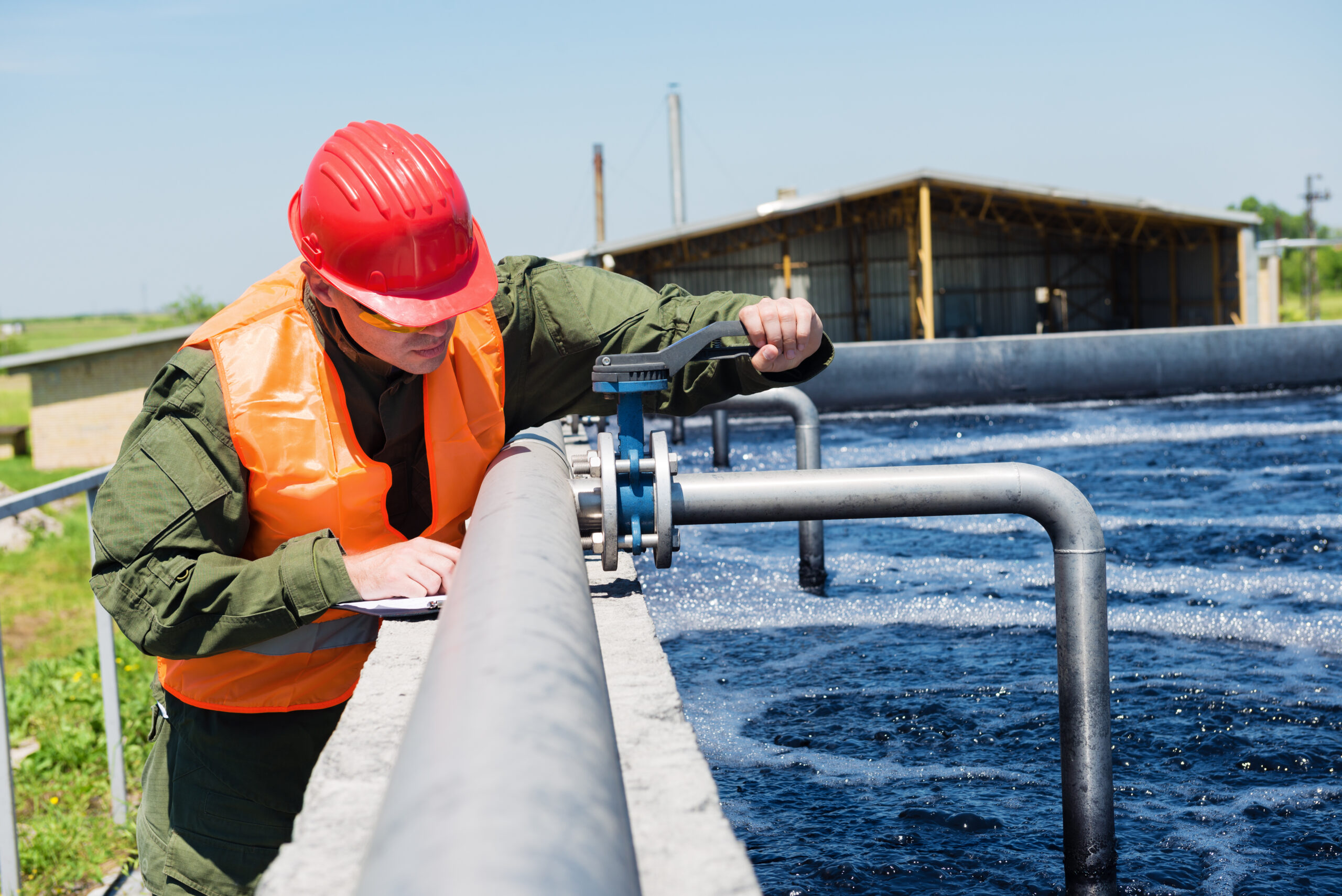 When operating a business that produces hazardous waste, proactive management can go a long way. Recycle and reuse materials when possible, and store hazardous waste properly until it can be recycled or discarded.
When operating a business that produces hazardous waste, proactive management can go a long way. Recycle and reuse materials when possible, and store hazardous waste properly until it can be recycled or discarded.
Environmental experts such as the team at McFadden Engineering support industrial companies through site assessment and necessary remediation, facility management and operations, water and wastewater treatment (which can be considered a form of hazardous waste recycling), environmental compliance and more.
Hazardous waste does not have to threaten environmental or human health. Instead, when waste is managed well and with expert support, companies can build public trust, reduce costs and lower the risk of environmental impact.
How to Help Your Organization “Go Green”
September 16, 2025
How to Help Your Organization “Go Green”
The “go green” movement has been growing and evolving for both individuals and businesses for decades. While simple swaps and environmentally conscious habits around daily living can support sustainability efforts at home, businesses that embrace going green have an opportunity to make a difference in their communities while boosting their bottom line.
Create an Eco-Friendly Culture
Buy-in from employees is a critical component of successful green office efforts. Educating employees about how they can play a role in sustainability efforts during their day-to-day work is a great first step. Encourage recycling, reusable water bottles, turning off electronics at the end of the day, environmentally conscious transportation and other small habits that, when added up, foster an eco-friendly culture.
Additionally, investing in environmentally friendly daily-use equipment can indicate to employees that the company takes sustainability seriously. Using hybrid or solar power systems, low-pressure water systems and rainwater collection tanks at the office are good places to start and can help lower utility costs over time.
For companies that operate machinery, water recycling can be an excellent option to cool systems and wash equipment while reducing operating and utility costs. Efficient use of water can also help conserve resources and save money – this could include operating water-based machinery when fully loaded, turning the air conditioning off when not in use and only using cooling equipment when necessary.
Transparency Builds Trust
Building an eco-friendly culture within an organization and following proper protocols for permitting and environmental compliance can help put your company on the map as a trustworthy, sustainability-focused business. Consumer perception is important, as many consumers are making sustainability a priority in their own lives and want the companies they buy from to do the same. Transparency about environmental wins, and even more importantly, any environmental issues, is crucial for building consumer trust.
Companies should aim to be authentic in their efforts to “go green” and document the steps taken along the way.
Outsource to the Environmental Experts
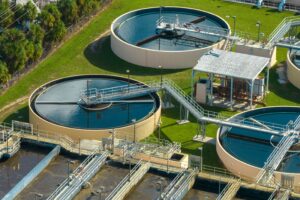 When it comes time to open a new physical location or embark on a new project where environmental regulations come into play, proper planning is crucial to success. An environmental engineering company can help develop master planning and conduct site assessments to help an organization remain in compliance and reduce the risk of excess spending and issues with the public down the road.
When it comes time to open a new physical location or embark on a new project where environmental regulations come into play, proper planning is crucial to success. An environmental engineering company can help develop master planning and conduct site assessments to help an organization remain in compliance and reduce the risk of excess spending and issues with the public down the road.
McFadden Engineering’s team is experienced in grading/drainage plan development, detention/retention design, stormwater management and other tasks that help businesses get their site up and running while keeping sustainability and compliance top of mind.
Once a plan is in place and initial assessments and permitting are complete, environmental engineering firms like McFadden Engineering can continue to support businesses in their sustainability efforts by managing facility operations, maintaining facility compliance, creating response plans for spills and developing treatment alternatives for permitted discharge limits. “Going green” is a continuous process, so having environmental engineers available to support large-scale sustainability efforts can ensure up-to-date and innovative solutions.
For more information about how McFadden Engineering can support your company in its sustainability efforts, view a list of our services.
Water Conservation 101: Protecting a Critical Natural Resource
August 20, 2025
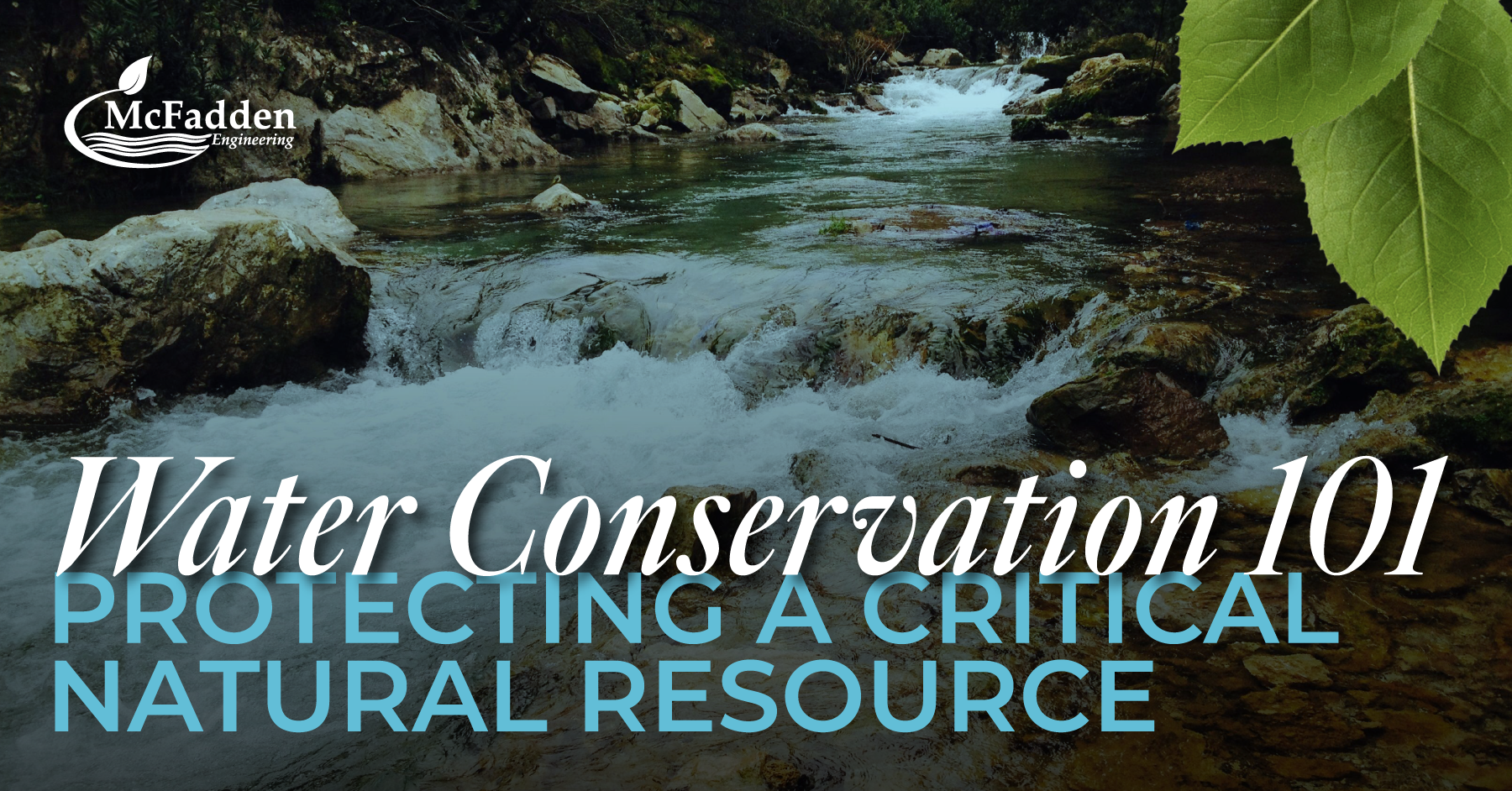
Water Conservation 101: Protecting a Critical Natural Resource
Clean water is essential to life on earth. It is key to individual health, supports agricultural needs and serves an important role in the environment, among other qualities. National Water Quality Month, recognized in the United States every August, offers the perfect opportunity to commit to conserving water both at home and on the job.
What are the Current Threats to Our Water Supply?
The population of earth has grown rapidly in the last century. More people lead to greater demand for clean water for drinking, bathing, washing dishes and clothing and other daily tasks. The influx in population also increases the need for crops and livestock, which require much water during the growing and production processes.
Water usage continues to climb, and simultaneous issues have emerged that threaten this precious resource that is already being stretched thin in some areas of the country and around the world. Sources of freshwater contamination include:
- Dumping effluent (liquid waste or sewage) from industrial sites
- Agricultural runoff
- Waste leakage that is left untreated
- Various chemicals and other contaminants people use at home
The U.S. Environmental Protection Agency (EPA), The Safe Drinking Water Act (SDWA), Clean Water Act (CWA) and water utility companies lead the way when it comes to water conservation and keeping our freshwater safe, but individuals and companies have a role to play, too.
 Industry Plays a Major Role in Protecting Water Resources
Industry Plays a Major Role in Protecting Water Resources
While it is important for individuals to keep water conservation top of mind when going about their daily activities, businesses and governments also share in the responsibility.
Development, construction, manufacturing, processing and other activities across a range of industrial sectors can leave a lasting footprint on communities and their environments if precautions are not taken to protect and conserve water. When industrial facilities do not take the proper steps to ensure environmental compliance, waste, chemicals and other contaminants can unknowingly migrate from the facility into surrounding land, groundwater and other water sources. This can lead to costly fines, expensive cleanup projects, reputation damage and, in some cases, harmful health effects to those in proximity to the leak.
McFadden Engineering specializes in supporting businesses in achieving environmental compliance and solving water and wastewater challenges, including:
- Site assessments
- Remediation
- Water and wastewater treatment
- Water quality and hydraulic monitoring
- Environmental compliance
How Individuals Play a Part in Water Conservation
It is critical for individuals and families to be mindful of the impact their activities can have on the environment, particularly our freshwater sources. While it is important to conserve water by using less of it whenever possible, it is just as – if not more – important to be conscious of accidentally allowing contaminants to enter water sources. Below are suggestions for water conservation at home:
- Turn the water off when not in use – be particularly aware when doing dishes, brushing teeth and watering plants.
- Fix leaky faucets and pipes promptly to avoid wasting water and eventual water damage.
- Pick up after pets: do not leave waste on the ground, as it can be washed away into water sources.
- Wash the car at the car wash: car washes are required to collect and treat dirty water and cleaning agents, so they do not enter the environment.
- Avoid fertilizing your yard, especially phosphorous-based fertilizer.
- Dispose of leftover paint, oil, antifreeze and similar products properly – your city or county should have instructions on disposal protocol. These products should not be put out with the regular garbage for disposal.
- Do not flush medications down the toilet: traces of contaminants can eventually be found in water sources.
- Use a rain barrel to collect rainwater for simple water reuse at home.
- Volunteer to help clean up a creek, beach or roadside near your home.
While National Water Quality Month offers a needed reminder of the importance of protecting water as a natural resource, both individuals and industry must build water conservation into their routines every day of the year.
McFadden Engineering Team Spotlight
July 23, 2025
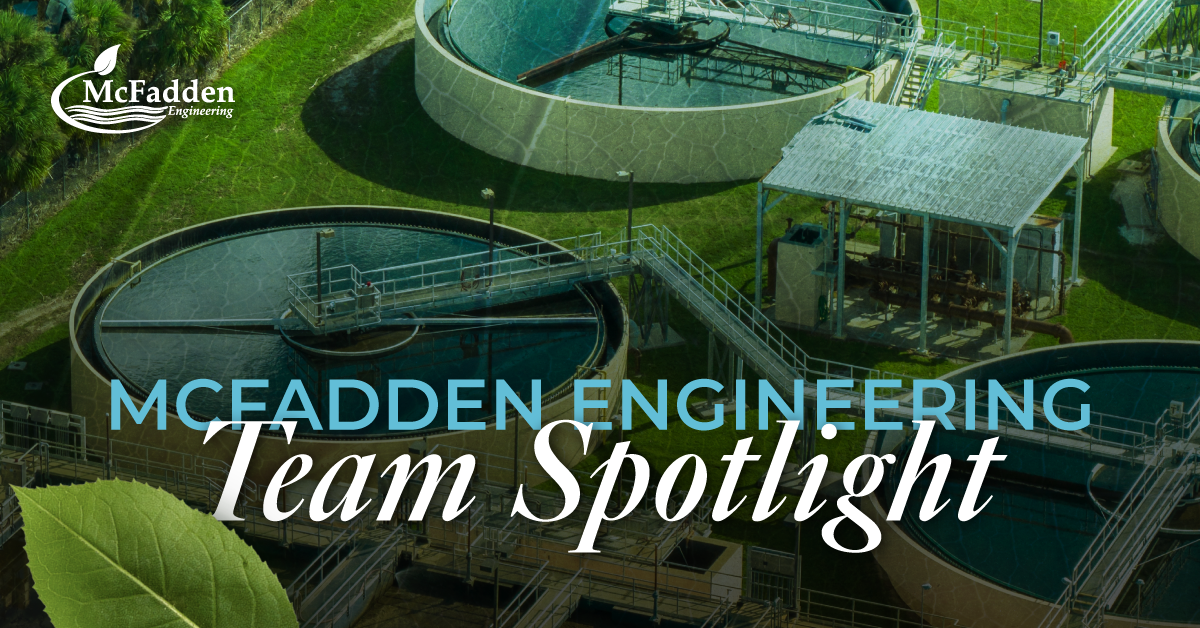
McFadden Engineering Team Spotlight
With roots in Mobile, Alabama, McFadden Engineering brings nearly a century of combined experience in civil and environmental engineering to the Southeastern United States. Our team of professional engineers and geologists are licensed in Alabama, Florida, Georgia, Louisiana, Tennessee and Mississippi, and are ready to solve unique civil and environmental engineering challenges through our integrative and innovative approach. Keep reading to meet a few of the engineers on our team.
Meet Our Engineers
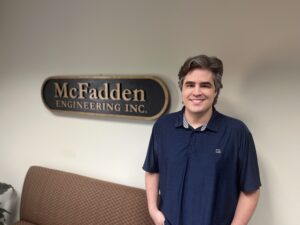 Nick Monson
Nick Monson
Nick Monson is a staff mechanical engineer with four years of professional experience. Since joining McFadden Engineering, his technical skills and collaborative spirit have made him a valuable member of the team. Monson appreciates McFadden Engineering’s supportive office culture.
“I am very happy with the office culture,” he says. “Everyone here is very helpful and accommodating, and there is a strong sense of mutual respect across the team.”
Always up for a challenge, Monson’s favorite project he has worked on is the Morton, Ill. pump stations—his first professional experience working with pump stations and piping.
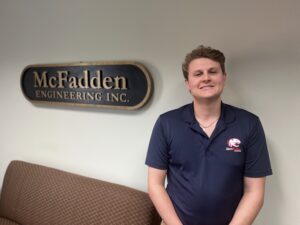 Harry McCaskill IV
Harry McCaskill IV
Harry McCaskill IV is a staff engineer with one year of professional experience. He brings a strong work ethic to the McFadden Engineering team and has embraced every opportunity to learn and grow.
“What I value most is the camaraderie in the office, McCaskill says. “Everyone works extremely well together, and they have done a lot to mentor me in the engineering field and in my personal life. I have grown more as an engineer since I started working with McFadden Engineering.”
McCaskill’s favorite project has involved designing an Oxyshark wastewater treatment system for the Nestle Plant in Illinois. The Nestle project was memorable as it was the first time he worked on a wastewater treatment project and his first time designing using AutoCAD.
Work with Our Team
McFadden Engineering offers a broad range of civil and environmental engineering services, tailoring solutions to meet the unique challenges of clients in a variety of business sectors. We deliver holistic solutions that go beyond technical facets, addressing financial concerns and anticipating the perceptions of regulatory agencies, outside parties and the public. We are licensed and have experience with regulations in Alabama, Florida, Georgia and Mississippi. To learn more about our services, visit our website.
Celebrating World Oceans Day
June 6, 2025

Celebrating World Oceans Day
World Oceans Day, observed annually on June 8, is a global event that highlights the vital role oceans play in sustaining life on Earth. This year marks the 31st anniversary of World Ocean Day. The celebration has united people worldwide as they work together toward the shared goal of keeping our oceans clean.
McFadden Engineering is headquartered in Mobile, Alabama, on the Alabama Gulf Coast, and is licensed in the states of Florida, Georgia, Louisiana, Mississippi, and Tennessee. Our connection to waterways that impact the overall health of our oceans runs deep. Our team has long been involved in efforts to maintain the cleanliness and beauty of our coastal environments.
What is World Oceans Day?
The concept of a ‘World Oceans Day’ was first proposed in 1992 at the Earth Summit in Rio de Janeiro to celebrate our world’s shared ocean and our connection to the sea, as well as to raise awareness about the crucial role the ocean plays in our lives and the important ways people can help protect it, according to the United Nations.
On this day, communities worldwide celebrate our appreciation for the world’s oceans and recommit to preserving their health. World Ocean Day serves as a call to action for stronger ocean and climate policies. Global coordination for World Ocean Day began in 2002, spearheaded by The Ocean Project and has been officially recognized by the United Nations since 2008. Today, World Ocean Day brings together youth, NGOs, businesses, aquariums, schools, governments and many others to honor and safeguard our ocean.
Despite covering more than 70% of our planet, much of the ocean remains unexplored, according to NOAA. Yet, oceans function as the Earth’s “lungs,” producing a significant portion of the oxygen we breathe and playing a crucial role in regulating the climate.
McFadden Engineering Environmental Services
Environmental Compliance to Protect Our Waterways
McFadden Engineering maintains strong, long-standing relationships with local, state and federal regulatory agencies, enabling us to efficiently manage the environmental permitting process on behalf of our clients. We work to save clients both time and resources. We also conduct compliance audits to help clients fulfill their environmental responsibilities and remain in full legal compliance. Our permitting expertise spans both public and private sector projects and includes:
- National Pollutant Discharge Elimination System (NPDES) permits for the discharge of treated wastewater and stormwater to surface waters
- Construction general permits for land-disturbing activities
- Industrial general NPDES permits for specific industrial operations and discharges
- Underground Injection Control (UIC) permits for subsurface discharge of treated wastewater and stormwater
- Water withdrawal permits for potable water systems and industrial processes
- U.S. Army Corps of Engineers permits for work conducted in navigable waterways
Water Quality and Hydraulic Modeling
For more than 30 years, McFadden Engineering has been at the forefront of water quality modeling, contributing to the development of some of the earliest models adopted by the Alabama Department of Environmental Management (ADEM). Our team applies advanced modeling techniques to assess the environmental impacts of wastewater discharges, industrial operations and land development. We develop and interpret custom water quality models for use by municipalities, private clients and regulatory bodies.
While hydraulic modeling primarily focuses on rivers, streams, lakes, and other hydrological systems within land, it can significantly impact waterways and, in turn, oceans in several ways:
- Infrastructure Design: Engineers use these models to design safer bridges, dams, and stormwater systems that can handle expected water flows
- Environmental Impact Analysis: Hydraulic modeling helps assess the potential impact of projects on local water systems, including downstream impacts that eventually affect coastal areas and oceans
- Water Quality Management: Some models can simulate the transport and deposition of pollutants, sediments and nutrients, aiding in the design of infrastructure that supports cleaner waterways, ultimately benefiting the ocean
Environmental Engineering Services
We offer a comprehensive range of environmental engineering services focused on minimizing environmental impacts from both natural events and human activities. Our capabilities include:
- Designing best management practices (BMPs) for regulatory compliance
- Developing spill prevention and response plans for industrial facilities
- Identifying effective treatment strategies to meet permitted discharge standards
McFadden Engineering’s team of water and wastewater experts specializes in providing environmentally sound solutions to solve unique civil and environmental engineering needs. Based in Mobile, Ala., for more than 30 years, McFadden Engineering has engineered solutions that positively impact wetlands, surface and raw water sources that flow to our oceans. Visit mcfaddenengineering.com for more information.
Managing Low and High Flow Specialty Wastewater with OxyShark®
May 22, 2025

Managing Low and High Flow Specialty Wastewater with OxyShark®
The McFadden Engineering team has developed OxyShark®, a multi-celled, fixed-film bioreactor, capable of handling hundreds of thousands of gallons of wastewater per day. The system can accommodate virtually any flow rate to meet the unique needs of a customer. Continue reading to learn more about the system, its applications, and the patented process.
Facilities that produce specialty wastewater face significant challenges due to chemical contaminants that traditional systems can’t handle. In rural areas, where access to municipal sewers is often lacking, the problem is even more pressing. These situations demand custom solutions that enhance existing wastewater treatment processes while supporting sustainability and operational efficiency. In industrial applications such as food processing, breweries and pharmaceutical production, treatment is necessary to meet regulatory and POTW limits.
OxyShark®: A Specialty Wastewater Solution
OxyShark® treats wastewater for discharge, reuse (e.g., washdown, cooling, landscaping), or regulatory compliance without hazardous chemicals, relying solely on beneficial bacteria and oxygen. This approach minimizes environmental risk and eliminates the cost of chemical treatments.
How It Works
For waste streams with pathogens or complex organics, OxyShark® offers a modular, multi-stage system. Additional pre- or post-treatment steps such as settling, clarification, filtration or chemical dosing can be added to suit specific needs. Ozone may also be applied in the final stage to remove odor, color and pathogens. These integrations maintain high efficiency without slowing operations.
Supporting Global Water Sustainability
Industrial and human activities pollute much of the world’s freshwater. Standard wastewater contains organic matter, nutrients, pathogens and toxins—all requiring treatment before safe discharge or reuse. OxyShark® uses biological processes: anaerobic digestion followed by aerobic treatment, along with nutrient removal and disinfection via ozone or UV.
Water recycling and conservation are key to global water security. Recycled water supports ecosystems, reduces the demand for freshwater, advancing a circular water economy and long-term sustainability.
OxyShark® is designed to be a versatile technology across specialty wastewater treatment needs and has delivered effective wastewater treatment solutions across a range of industries, from car washes to landfill management.
How OxyShark ® Can Work for You: Case Studies
Rich’s Car Wash
Car washes consume large volumes of water, leading to high utility costs and pressure on local water infrastructure. Rich’s Car Wash faced rising costs for both water use and wastewater disposal through the municipal system. OxyShark® provided a tailored solution capable of processing up to 20,000 gallons per day with a wastewater strength of approximately 140 mg/L BOD₅. The custom system not only met operational needs but also offered cost-saving benefits, enabling Richs to manage water more efficiently and sustainably.
Landfill Condensate Treatment
Landfill condensate presents variable and challenging water chemistry. To ensure treatment effectiveness, OxyShark® conducted lab analyses and treatability studies. The goal was to reduce BOD₅ levels to below 1,000 mg/L for discharge to the sanitary sewer and to evaluate the feasibility of reclaiming the treated water for onsite reuse, such as in cooling tower operations. These efforts demonstrated OxyShark®’s flexibility in handling complex waste streams and meeting regulatory standards.
McFadden Engineering’s team of water and wastewater experts specializes in providing environmentally sound solutions to solve unique civil and environmental engineering needs. Visit the OxyShark® website for more information or contact our team today to inquire about how the OxyShark ® system can serve your specialty wastewater needs.
McFadden Celebrates Earth Day
April 18, 2025
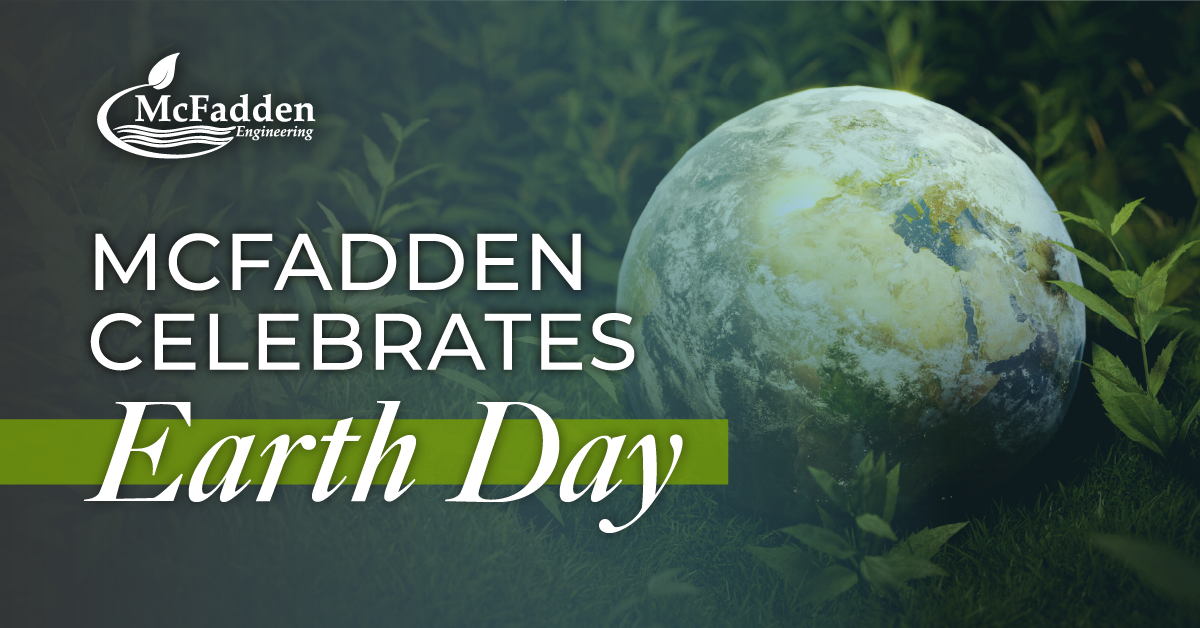
McFadden Celebrates Earth Day
For 55 years, Earth Day has played a leading role in raising awareness and inspiring action on critical environmental challenges. It serves as a global advocate for the health of our planet—protecting our air, oceans, soil, ecosystems, wildlife and human wellbeing. At McFadden, we strive to design systems that protect water as a natural resource.
The infrastructure we create must not only meet needs but also respect the balance of the ecosystems around us. At McFadden Engineering, we are dedicated to developing forward-thinking engineering solutions that benefit the specific communities where our team provides services and to the world.
What is Earth Day?
Before Earth Day started in 1970, there were few environmental regulations. Earth Day was established to raise awareness about protecting the environment through safeguards for handling toxic materials and ensuring safe drinking water to protect water resources. On April 22, 2025, an estimated one billion people across 192 countries are expected to participate in Earth Day events. McFadden will celebrate this occasion by highlighting our commitment to designing water systems that prioritize low environmental impact with our services in hydraulic monitoring and site assessment and remediation for our municipal and industrial clients
Since the start of Earth Day, numerous laws and regulations, including the Clean Air Act and the Clean Water Act, have been enacted to safeguard our environment and communities. The theme for Earth Day 2025, “OUR POWER, OUR PLANET,” calls on people worldwide to come together in support of renewable energy and work toward tripling the global production of clean electricity by 2030.
How McFadden is Engineering Sustainable Ecosystems
Civil engineers play a vital role in shaping sustainable solutions that enhance both the environment and community well-being. Our work encompasses optimizing water systems, designing industrial wastewater treatment, water quality and hydraulic monitoring, as well as site assessment and remediation through low-impact designs and the advancement of energy-efficient practices. Across all engineering disciplines, we are committed to finding innovative ways to preserve our environment.
Our mission as engineers is to develop infrastructure that is both sustainable and environmentally conscious. “As engineers, we have a responsibility to assist our clients in being good stewards of the environment and the natural resources that we have been blessed with. At McFadden Engineering, we take this responsibility seriously and strive to ensure that in every project we account for the potential impacts to the environment,” said Brad Newton, Vice President of McFadden Engineering.
We design systems that minimize ecological impacts, implement stormwater management solutions that enhance climate resilience, and address public health challenges such as lead service line replacement. McFadden creates designs that improve the quality of life for today’s communities while considering the needs of future generations.
McFadden Celebrates World Water Day
March 19, 2025
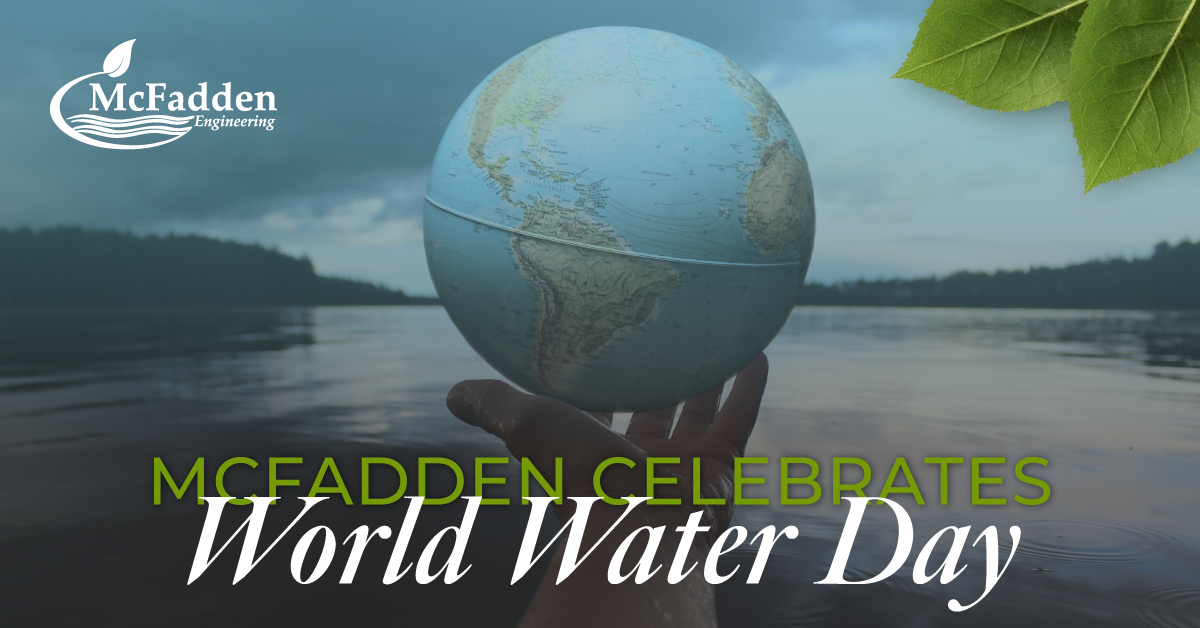
McFadden Celebrates World Water Day
McFadden Engineering will celebrate World Water Day on Saturday, March 22 as a part of our commitment to providing sustainable solutions for the essential role of water in our communities, ecosystems and planet. World Water Day was created by the United Nations to raise awareness of the 2.2 billion people living without access to safe water. It is about taking action to tackle the global water crisis. This year the theme of World Water Day is Glacier Preservation. Glaciers account for almost 2.1 percent of freshwater according to the USGS, making a difference for the core focus of World Water Day to support the achievement of water and sanitation for all by 2030.
To aid in providing access to fresh water for all by 2030, McFadden Engineering works to provide solutions that conserve water as a natural resource in every design and project we take on. Our philosophy is to manage water as a valuable resource, aiming to preserve or restore the natural water balance by replicating the natural cycle and fostering a self-sustaining, healthy ecosystem. McFadden’s team of engineers specializes in conducting professional assessments to optimize water treatment processes, identify water loss in systems and maximize water resources. Their process includes reviewing public site records, performing on-site inspections, conducting interviews, and carrying out additional tasks based on client requests. It is our goal to improve client water treatment systems with durable and efficient solutions that will be resilient in the fight against climate change.
For example, the services we provide include:
Water and wastewater treatment:
McFadden Engineering has extensive experience in managing drinking water and wastewater treatment. As a leader in water and wastewater process design in the Southeast, we deliver innovative systems to solve the most challenging problems. McFadden believes that by evaluating the water and wastewater needs of the client, a solution can be developed that specifically addresses the problem. No two clients are the same and our innovative approach to providing solutions expands our clients’ operational flexibility and allows for future growth.
Water quality and hydraulic monitoring:
McFadden Engineering has been on the leading edge of water quality modeling for more than 30 years, helping to develop some of the first water quality models used by the Alabama Department of Environmental Management (ADEM). Water quality modeling can be used to estimate the environmental impact of factors such as wastewater treatment plant discharges, industrial activity and commercial site development. Our engineers specialize in developing innovative water quality models and analyzing modeling results for private clients, municipalities and regulatory agencies.
Environmental engineering services:
McFadden Engineering provides general environmental engineering services aimed at protecting the environment from the impact of both natural and human activities. Our broad environmental engineering experience includes the development of best management practices for facility compliance, spill and response plan development for industrial clients and determining treatment alternatives for meeting permitted discharge limits.
Contact our team today about how these solutions can work for you and help us reach the goal of water for all by 2030.
